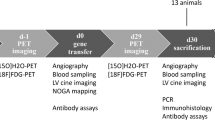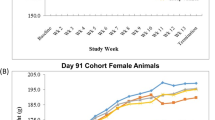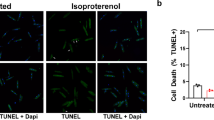Abstract
Adeno-associated viral vectors (AAV) are attractive tool for gene therapy for coronary artery disease. However, gene expression in myocardium mediated by AAV serotype 2 (AAV2) does not peak until 4–6 weeks after gene transfer. This delayed gene expression may reduce its therapeutic potential for acute cardiac infarction. To determine whether earlier gene expression and better therapeutic effect could be achieved using a different serotype, CMV promoter driving the EPO gene (AAV-EPO) was packaged into AAV serotypes 1–5 capsids and injected into mouse myocardium. EPO expression was studied by measuring the hematocrits and EPO mRNA. After we found that AAV1 mediates the highest gene expression after 4 days of gene transduction, AAV-LacZ (CMV promoter driving LacZ gene expression) and MLCVEGF (hypoxia-inducible and cardiac-specific VEGF expression) were packaged into AAV1 and 2 capsids. LacZ expression was detected in AAV1-LacZ but not in AAV2-LacZ-injected hearts 1 day after vector injection. Compared to AAV2-MLCVEGF that mediated no significant VEGF expression, AAV1-MLCVEGF mediated 13.7-fold induction of VEGF expression in ischemic hearts 4 days after gene transduction and resulted in more neovasculatures, better cardiac function and less myocardial fibrosis. Thus, AAV1 mediates earlier and higher transgene expression in myocardium and better therapeutic effects.
This is a preview of subscription content, access via your institution
Access options
Subscribe to this journal
Receive 12 print issues and online access
$259.00 per year
only $21.58 per issue
Buy this article
- Purchase on Springer Link
- Instant access to full article PDF
Prices may be subject to local taxes which are calculated during checkout







Similar content being viewed by others
References
Berns KI, Linden RM . The cryptic life style of adeno-associated virus. Bioessays 1995; 17: 237–245.
Vassalli G, Bueler H, Dudler J, von Segesser LK, Kappenberger L . Adeno-associated virus (AAV) vectors achieve prolonged transgene expression in mouse myocardium and arteries in vivo: a comparative study with adenovirus vectors. Int J Cardiol 2003; 90: 229–238.
Chu D, Sullivan CC, Weitzman MD, Du L, Wolf PL, Jamieson SW et al. Direct comparison of efficiency and stability of gene transfer into the mammalian heart using adeno-associated virus versus adenovirus vectors. J Thorac Cardiovasc Surg 2003; 126: 671–679.
Kaplitt MG, Xiao X, Samulski RJ, Li J, Ojamaa K, Klein IL et al. Long-term gene transfer in porcine myocardium after coronary infusion of an adeno-associated virus vector. Ann Thorac Surg 1996; 62: 1669–1676.
Wright MJ, Wightman LM, Lilley C, de Alwis M, Hart SL, Miller A et al. In vivo myocardial gene transfer: optimization, evaluation and direct comparison of gene transfer vectors. Basic Res Cardiol 2001; 96: 227–236.
Su H, Lu R, Kan YW . Adeno-associated viral vector-mediated vascular endothelial growth factor gene transfer induces neovascular formation in ischemic heart. Proc Natl Acad Sci USA 2000; 97: 13801–13806.
Su H, Arakawa-Hoyt J, Kan YW . Adeno-associated viral vector-mediated hypoxia response element-regulated gene expression in mouse ischemic heart model. Proc Natl Acad Sci USA 2002; 99: 9480–9485.
Su H, Joho S, Huang Y, Barcena A, Arakawa-Hoyt J, Grossman W et al. Adeno-associated viral vector delivers cardiac-specific and hypoxia-inducible VEGF expression in ischemic mouse hearts. Proc Natl Acad Sci USA 2004; 101: 16280–16285.
Agrawal RS, Muangman S, Layne MD, Melo L, Perrella MA, Lee RT et al. Pre-emptive gene therapy using recombinant adeno-associated virus delivery of extracellular superoxide dismutase protects heart against ischemic reperfusion injury, improves ventricular function and prolongs survival. Gene Therapy 2004; 11: 962–969.
Melo LG, Agrawal R, Zhang L, Rezvani M, Mangi AA, Ehsan A et al. Gene therapy strategy for long-term myocardial protection using adeno-associated virus-mediated delivery of heme oxygenase gene. Circulation 2002; 105: 602–607.
Jennings RB, Murry CE, Steenbergen Jr C, Reimer KA . Development of cell injury in sustained acute ischemia. Circulation 1990; 82: II2–II12.
Xiao W, Chirmule N, Berta SC, McCullough B, Gao G, Wilson JM . Gene therapy vectors based on adeno-associated virus type 1. J Virol 1999; 73: 3994–4003.
Muramatsu S, Mizukami H, Young NS, Brown KE . Nucleotide sequencing and generation of an infectious clone of adeno-associated virus 3. Virology 1996; 221: 208–217.
Chiorini JA, Yang L, Liu Y, Safer B, Kotin RM . Cloning of adeno-associated virus type 4 (AAV4) and generation of recombinant AAV4 particles. J Virol 1997; 71: 6823–6833.
Chiorini JA, Kim F, Yang L, Kotin RM . Cloning and characterization of adeno-associated virus type 5. J Virol 1999; 73: 1309–1319.
Rutledge EA, Halbert CL, Russell DW . Infectious clones and vectors derived from adeno-associated virus (AAV) serotypes other than AAV type 2. J Virol 1998; 72: 309–319.
Gao GP, Alvira MR, Wang L, Calcedo R, Johnston J, Wilson JM . Novel adeno-associated viruses from rhesus monkeys as vectors for human gene therapy. Proc Natl Acad Sci USA 2002; 99: 11854–11859.
Weber M, Rabinowitz J, Provost N, Conrath H, Folliot S, Briot D et al. Recombinant adeno-associated virus serotype 4 mediates unique and exclusive long-term transduction of retinal pigmented epithelium in rat, dog, and nonhuman primate after subretinal delivery. Mol Ther 2003; 7: 774–781.
Zabner J, Seiler M, Walters R, Kotin RM, Fulgeras W, Davidson BL et al. Adeno-associated virus type 5 (AAV5) but not AAV2 binds to the apical surfaces of airway epithelia and facilitates gene transfer. J Virol 2000; 74: 3852–3858.
Davidson BL, Stein CS, Heth JA, Martins I, Kotin RM, Derksen TA et al. Recombinant adeno-associated virus type 2, 4, and 5 vectors: transduction of variant cell types and regions in the mammalian central nervous system. Proc Natl Acad Sci USA 2000; 97: 3428–3432.
Chao H, Liu Y, Rabinowitz J, Li C, Samulski RJ, Walsh CE . Several log increase in therapeutic transgene delivery by distinct adeno-associated viral serotype vectors. Mol Ther 2000; 2: 619–623.
Chao H, Monahan PE, Liu Y, Samulski RJ, Walsh CE . Sustained and complete phenotype correction of hemophilia B mice following intramuscular injection of AAV1 serotype vectors. Mol Ther 2001; 4: 217–222.
Duan D, Yan Z, Yue Y, Ding W, Engelhardt JF . Enhancement of muscle gene delivery with pseudotyped adeno-associated virus type 5 correlates with myoblast differentiation. J Virol 2001; 75: 7662–7671.
Du L, Kido M, Lee DV, Rabinowitz JE, Samulski RJ, Jamieson SW et al. Differential myocardial gene delivery by recombinant serotype-specific adeno-associated viral vectors. Mol Ther 2004; 10: 604–608.
Kawamoto S, Shi Q, Nitta Y, Miyazaki J, Allen MD . Widespread and early myocardial gene expression by adeno-associated virus vector type 6 with a beta-actin hybrid promoter. Mol Ther 2005; 11: 980–985.
Wang GL, Jiang BH, Rue EA, Semenza GL . Hypoxia-inducible factor 1 is a basic-helix-loop-helix-PAS heterodimer regulated by cellular O2 tension. Proc Natl Acad Sci USA 1995; 92: 5510–5514.
Wang GL, Semenza GL . Purification and characterization of hypoxia-inducible factor 1. J Biol Chem 1995; 270: 1230–1237.
Jiang BH, Rue E, Wang GL, Roe R, Semenza GL . Dimerization, DNA binding, and transactivation properties of hypoxia-inducible factor 1. J Biol Chem 1996; 271: 17771–17778.
Chavez JC, Agani F, Pichiule P, LaManna JC . Expression of hypoxia-inducible factor-1alpha in the brain of rats during chronic hypoxia. J Appl Physiol 2000; 89: 1937–1942.
Ferrari FK, Samulski T, Shenk T, Samulski RJ . Second-strand synthesis is a rate-limiting step for efficient transduction by recombinant adeno-associated virus vectors. J Virol 1996; 70: 3227–3234.
Vincent-Lacaze N, Snyder RO, Gluzman R, Bohl D, Lagarde C, Danos O . Structure of adeno-associated virus vector DNA following transduction of the skeletal muscle. J Virol 1999; 73: 1949–1955.
Burger C, Gorbatyuk OS, Velardo MJ, Peden CS, Williams P, Zolotukhin S et al. Recombinant AAV viral vectors pseudotyped with viral capsids from serotypes 1, 2, and 5 display differential efficiency and cell tropism after delivery to different regions of the central nervous system. Mol Ther 2004; 10: 302–317.
Lipshutz GS, Titre D, Brindle M, Bisconte AR, Contag CH, Gaensler KM . Comparison of gene expression after intraperitoneal delivery of AAV2 or AAV5 in utero. Mol Ther 2003; 8: 90–98.
Passini MA, Watson DJ, Vite CH, Landsburg DJ, Feigenbaum AL, Wolfe JH . Intraventricular brain injection of adeno-associated virus type 1 (AAV1) in neonatal mice results in complementary patterns of neuronal transduction to AAV2 and total long-term correction of storage lesions in the brains of beta-glucuronidase-deficient mice. J Virol 2003; 77: 7034–7040.
Rabinowitz JE, Bowles DE, Faust SM, Ledford JG, Cunningham SE, Samulski RJ . Cross-dressing the virion: the transcapsidation of adeno-associated virus serotypes functionally defines subgroups. J Virol 2004; 78: 4421–4432.
Rabinowitz JE, Rolling F, Li C, Conrath H, Xiao W, Xiao X et al. Cross-packaging of a single adeno-associated virus (AAV) type 2 vector genome into multiple AAV serotypes enables transduction with broad specificity. J Virol 2002; 76: 791–801.
Blankinship MJ, Gregorevic P, Allen JM, Harper SQ, Harper H, Halbert CL et al. Efficient transduction of skeletal muscle using vectors based on adeno-associated virus serotype 6. Mol Ther 2004; 10: 671–678.
Wang Z, Zhu T, Qiao C, Zhou L, Wang B, Zhang J et al. Adeno-associated virus serotype 8 efficiently delivers genes to muscle and heart. Nat Biotechnol 2005; 23: 321–328.
Summerford C, Samulski RJ . Membrane-associated heparan sulfate proteoglycan is a receptor for adeno-associated virus type 2 virions. J Virol 1998; 72: 1438–1445.
Hauck B, Xiao W . Characterization of tissue tropism determinants of adeno-associated virus type 1. J Virol 2003; 77: 2768–2774.
Chen S, Kapturczak M, Loiler SA, Zolotukhin S, Glushakova OY, Madsen KM et al. Efficient transduction of vascular endothelial cells with recombinant adeno-associated virus serotype 1 and 5 vectors. Hum Gene Ther 2005; 16: 235–247.
Luo Z, Diaco M, Murohara T, Ferrara N, Isner JM, Symes JF . Vascular endothelial growth factor attenuates myocardial ischemia-reperfusion injury. Ann Thorac Surg 1997; 64: 993–998.
Ziche M, Morbidelli L, Choudhuri R, Zhang HT, Donnini S, Granger HJ et al. Nitric oxide synthase lies downstream from vascular endothelial growth factor-induced but not basic fibroblast growth factor-induced angiogenesis. J Clin Invest 1997; 99: 2625–2634.
Eriksson U, Alitalo K . VEGF receptor 1 stimulates stem-cell recruitment and new hope for angiogenesis therapies. Nat Med 2002; 8: 775–777.
Markkanen JE, Rissanen TT, Kivela A, Yla-Herttuala S . Growth factor-induced therapeutic angiogenesis and arteriogenesis in the heart–gene therapy. Cardiovasc Res 2005; 65: 656–664.
Matsushita T, Elliger S, Elliger C, Podsakoff G, Villarreal L, Kurtzman GJ et al. Adeno-associated virus vectors can be efficiently produced without helper virus. Gene Therapy 1998; 5: 938–945.
Ishizaka S, Sievers RE, Zhu BQ, Rodrigo MC, Joho S, Foster E et al. New technique for measurement of left ventricular pressure in conscious mice. Am J Physiol Heart Circ Physiol 2004; 286: H1208–H1215.
Acknowledgements
This work was supported by a National Institutes of Health Grant, HL67969 (YWK) and in part a grant from the Wayne and Gladys Valley Foundation (WG). We thank Dr Xiao Xiao for providing us the AAV serotypes 1, 3, 4 and 5 capsid plasmids.
Author information
Authors and Affiliations
Corresponding author
Rights and permissions
About this article
Cite this article
Su, H., Huang, Y., Takagawa, J. et al. AAV Serotype-1 mediates early onset of gene expression in mouse hearts and results in better therapeutic effect. Gene Ther 13, 1495–1502 (2006). https://doi.org/10.1038/sj.gt.3302787
Received:
Revised:
Accepted:
Published:
Issue Date:
DOI: https://doi.org/10.1038/sj.gt.3302787
Keywords
This article is cited by
-
Comparative analysis of adeno-associated virus serotypes for gene transfer in organotypic heart slices
Journal of Translational Medicine (2020)
-
Promise of adeno-associated virus as a gene therapy vector for cardiovascular diseases
Heart Failure Reviews (2017)
-
Inhibition of pathological brain angiogenesis through systemic delivery of AAV vector expressing soluble FLT1
Gene Therapy (2015)
-
Creation of a cardiotropic adeno-associated virus: the story of viral directed evolution
Virology Journal (2013)
-
Gene therapy using IL-27 ameliorates Sjögren's syndrome-like autoimmune exocrinopathy
Arthritis Research & Therapy (2012)



